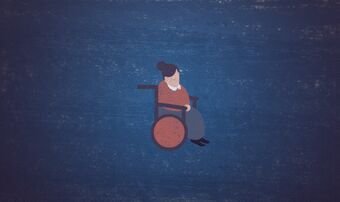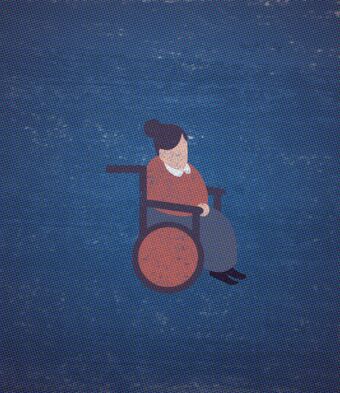Professor John Wyatt examines the Assisted Dying Bill in the House of Lords, looking at the underlying thinking behind it and all the problems with it.
Baroness Meacher introduced her Assisted Dying Bill to the House of Lords in May 2021. It states that lethal medication can be provided by a doctor to an individual who has:
a) a voluntary, clear, settled and informed wish to end his or her own life;
b) has legal capacity to make the decision to end his or her own life;
c) has been diagnosed by a registered medical practitioner as having an inevitably progressive condition which cannot be reversed by treatment (“a terminal illness”); and as a consequence of that terminal illness, is reasonably expected to die within six months.
The individual concerned must sign a formal legal declaration that they wish to end their life and this must be countersigned by two medical professionals. A waiting period of 14 days is mandated before lethal medication can be given, reduced to 6 days in the case of imminent death from terminal illness.
The medical professionals must confirm that the individual “has a clear and settled intention to end their own life which has been reached voluntarily, on an informed basis and without coercion or duress.”
The Bill states that, following the prescription of lethal medication, an assisting health professional may prepare the drugs for self-administration by the person, may prepare a medical device (such as an intravenous infusion pump) for administration of the drugs and may assist the person to ingest or otherwise self-administer the medicine. However the Bill states, “the decision to self-administer the medicine and the final act of doing so must be taken by the person for whom the medicine has been prescribed.”
With regard to conscientious objection on behalf of health professionals the Bill states: “A person is not under any duty (whether by contract or arising from any statutory or other legal requirement) to participate in anything authorised by this Act to which that person has a conscientious objection.”
The Meacher Bill is currently passing through the House of Lords and a formal debate is expected in Autumn 2021. Similar legislation is about to be introduced into the Scottish Parliament by Liam McArthur MSP.
What’s behind this bill?
It is immediately apparent that there are a number of practical problems and inconsistencies with the Meacher Bill which I will outline in the remainder of this article. But first it’s important to consider the Bill’s underlying assumptions and philosophy.
i) underlying assumptions and philosophy.
Although the Bill is entitled “Assisted Dying”, it’s intention is to enable lethal medication to be prescribed so that certain people can kill themselves. Although in current English law, assisting someone who wishes to commit suicide is a serious criminal offence, with a penalty of up to 14 years imprisonment, the underlying philosophy of the Meacher Bill is that there is such a thing as a rational and legally justified suicide.
So what are the criteria that make a suicide rational and worthy of legal assistance? They are first, being an adult with a settled and ‘uncoerced’ will to kill oneself, second, having a life expectancy of less than 6 months, and third, having legally defined ‘capacity’, in other words the absence of significant mental impairment.
It is notable that the Meacher Bill makes no mention of suffering. It is not necessary for the person who wishes to kill themselves to exhibit any degree of suffering before being eligible for suicide. This is in stark contrast to similar legislation in Netherlands, where the criterion is ‘hopeless and unbearable suffering’, or in Canada where a person must have ‘enduring and intolerable physical or psychological suffering that cannot be alleviated under conditions the person considers acceptable.’
In an article about the Meacher Bill in the Times Newspaper, the banner headline proclaimed “Assisted dying bill aims to stop ‘unbearable suffering’”, quoting Baroness Meacher as saying she wanted to alleviate “intolerable suffering”2. But ‘suffering’ is nowhere mentioned in the wording of the Bill. In order to be eligible for suicide, it is not necessary for the person to give any reason as to why they wish to end their life. They simply have to demonstrate a ‘settled wish’.
So the proposed UK legislation is based on the presumption that the suicide of a person with limited life expectancy should be supported and facilitated whatever the motivation, provided that person has legal capacity and is ‘un-coerced’.
For comparison it is worth looking at analogous legislation, the Medical Aid in Dying Bill in Canada3. Here, in order to be eligible for “medical aid in dying” (which covers both euthanasia and assisted suicide), it is necessary for all three of the following criteria to be fulfilled:
i) have a serious and incurable illness, disease or disability,
ii) be in an advanced state of irreversible decline in capability and
iii) have enduring and intolerable physical or psychological suffering that cannot be alleviated under conditions the person considers acceptable.
None of these criteria are required according to the Meacher Bill. The only requirement is a life expectancy of less than 6 months.
But it is immediately obvious that the underlying philosophy of the Bill is deeply problematic. If the real motivation is to limit ‘intolerable suffering’, then why should limited life expectancy of less than 6 months be a rational reason for suicide, whilst unbearable suffering is not? Surely it might be argued that the suffering of someone with a progressive medical condition who has several years to live, is greater and more worthy of our compassion, than someone who has only a few months to live. Similarly, if Baroness Meacher is concerned about ‘stopping unbearable suffering’, why is there no provision to end the lives of those who, though suffering terribly, have lost their legal capacity because of their illness?
ii) ‘Reasonably expected to die in less than 6 months’
The Bill assumes that taking such a momentous decision as to allow a person to kill themselves, can be based on two doctors’ prediction that they have less than 6 months to live. But it is well known that medical prediction of life expectancy is extremely unreliable, especially when carried out by doctors who are not specialists in terminal care. As an experienced NHS consultant I am aware of many examples when I and my colleagues were hopelessly wrong in predicting how many months or years a person had to live. It is not uncommon for a person who is thought to have a ‘terminal illness’ to live on for years. This may be due to mistaken diagnosis, sudden unexpected spontaneous remission, or the development of new treatments and medications. But prescribing lethal medication means that the prediction of death is of course a self-fulfilling prophecy. No-one will know that the person killed themselves unnecessarily, in the mistaken belief that they only had weeks to live.
Of course, the other problem with the life expectancy criteria is the arbitrary selection of less than 6 months, with a further 14 days waiting period. Why on earth is it rational to kill yourself if thought to have 5 months to live but not 7 months? Other legislation has suggested a 12 months limit or longer. It is wearyingly predictable that if the Assisted Dying Bill was passed into law there would be an immediate set of legal challenges to the 6 month criterion. Tragic cases will be presented to the public of people with severe neurological illnesses, such as motor neuron disease, who are desperate to kill themselves but who don’t meet the 6 month limit. Don’t these tragic people demand our compassion too? On what logical grounds can we exclude these people from assisted suicide whilst offering it to those who are about to die? Since there is no rational basis to support the arbitrary 6 months limit, what rational argument can withstand compassionate extension to 8 months, 10 months, 12 months and so on?
In Canada, the Medical Aid in Dying (MAiD) bill to allow assisted suicide and euthanasia, used the phrase ‘a reasonably foreseeable natural death’. Initially this was interpreted by Canadian doctors and lawyers to mean less than 6 months to live, but there was an immediate legal challenge, based on the case of an elderly person of 89 years with the degenerative condition of spinal stenosis. The court had determined she was eligible for MAiD, but pro-euthanasia activists argued that she was not terminally ill and her life expectancy was in fact 5-6 years. On this basis a number of Canadian doctors have argued that it was legal to end the lives of people who meet the criteria of suffering with an incurable condition but who have many years to live. So far there have been no prosecutions of doctors under the MAiD Act.
There is no doubt that UK activists are learning from developments following end of life legislation in other countries, and that similar legal challenges will commence as soon as any legislation is passed in the UK.
iii) a ‘voluntary, informed decision without coercion or duress’
It is the responsibility of the certifying doctors to confirm that there is no coercion or duress. But of course the precise meaning of coercion or duress, in the context of a desire to end one’s life, is debatable. Consider an elderly person who has a great fear of being a burden to his or her loved ones and who wishes to end their life to avoid this. Is it possible that the relatives are applying subtle pressure and covert manipulation? Both abuse and abandonment of elderly people is shockingly common in our society. How is it possible to avoid inappropriate pressure being applied to elderly and vulnerable people? Most busy doctors are simply ill-equipped and inadequately trained to detect subtle forms of social manipulation and coercion.
In the US state of Oregon, where assisted suicide legislation has been in force for many years, between 40 and 60% of people have given ‘perceiving self as being a burden to others’ as a reason for choosing to kill themselves4. It is common to find elderly people who are concerned that they are becoming an unwanted burden on their relatives and carers. Desiring to act responsibly and altruistically, they may come to believe that it would be better for everybody if their life came to an end. There is a deep and tragic irony that it is precisely those elderly people who are most sensitive to the needs and concerns of others who may be most at risk of being emotionally manipulated into taking their own lives.
And can we or others always detect the covert influences and emotional factors which lie behind our choices? In the words of Professor Nigel Biggar, the notion that we are all rational choosers is a flattering lie told us by people who want to sell us something. If Freud has taught the heirs of modernity anything, it is the uncomfortable truth that much of the time we are influenced and motivated by social and psychological forces that we barely understand.
Another common reason given for assisted suicide in Oregon is ‘fear of inability to care for self’. There have been well-documented cases in which worries about the lack of provision of high quality palliative care have been a motivating factor for terminally ill patients to seek suicide. If the Meacher Bill becomes law in England it seems likely that some vulnerable people with medical conditions will seek to end their lives because of obvious deficiencies in the social and medical support they are likely to get. But is this something that we as a society should be facilitating by providing lethal medications?
iv) legal capacity to decide to end your life
Depression is common in terminal illness and suicidal thoughts are a cardinal symptom of depression. So is it possible for a person with depression to make a rational choice to end their own life? Is the desire to end their own life based on a rational appraisal of their situation or is their perception being distorted through depression. One psychologist who had studied people seeking medically assisted suicide in Oregon argued that the distinction was not clear, stating "…of the people who pursue this option, a sizable portion are rationally appraising their situation. And a sizable proportion are appraising it through a lens of depression." Some in favour of the legislation argue that depression shouldn't necessarily make a person ineligible for physician-assisted suicide. It might be argued that in the normal course of life we don’t say that people lose autonomy to make decisions even if they are moderately depressed. Perhaps a degree of depression is a rational response to approaching death. As one commentator put it "How cheerful should you be when you have a terminal illness?"
And what about the person in severe pain who expresses a clear wish to end their own lives and are assessed as suitable to receive the lethal medication. But during the 14 day waiting period the disease progresses and they become rather confused. Now according to the proposed legislation they must not be given the lethal medication even if they ask for it, because they have lost legal capacity. But how tenable is this? And can we be confident that health professionals will withhold lethal medication under these distressing circumstances?
v) ensuring a clean death
(This section contains some rather grisly medical details and those of a sensitive disposition may wish to skip to the next section). When the euthanasia doctors started killing people some years ago in the Netherlands, they didn’t know how to do it. It wasn’t the sort of thing you got taught at medical school. There were a number of macabre experiments in which doctors tried injecting air into people’s veins, using helium gas or massive overdoses of insulin. But over the years a highly efficient method of killing has evolved, using massive overdoses of old-fashioned sedative drugs called barbiturates. The standard technique involves a dose of 50-100 times the therapeutic dose of a barbiturate. When injected into a vein, and combined with a drug to stop all breathing activity, unconsciousness and death occurs within seconds. This is the method used in thousands of cases every year in the Netherlands and Canada.
But the Assisted Dying Bill in the UK implies that doctors will prescribe lethal barbiturate medication which will be taken orally by the person seeking to kill themselves. In a research study of the Netherlands experience of assisted suicide, published in the New England Journal of Medicine6, complications occurred in 7% of cases of assisted suicide, and problems with completion (a longer-than-expected time to death, failure to induce coma, or induction of coma followed by awakening of the patient) occurred in 16% of cases. The physician decided to administer a lethal medication (intravenously) in 18% of the cases of assisted suicide because of ‘problems with the procedure’.
Following oral administration of large doses of barbiturates there are reports of extreme gasping and muscle spasms. While losing consciousness, vomiting and aspiration may occur. Panic, feelings of terror and assaultive behaviour may take place from the drug-induced confusion. The Royal Dutch Medical Association recommends that a doctor be present when assisted suicide is performed, precisely so that a lethal intravenous injection can be given if necessary.
A Dutch doctor with practical experience of both voluntary euthanasia and assisted suicide said, “Thinking that physician-assisted suicide is the entire answer to the question of ending of life of a suffering patient…is a fantasy. There will always be patients who cannot drink, or are semiconscious, or prefer that a physician perform this act. Experience has taught us that there are many cases of assisted suicide in which the suicide fails. Physicians need to be aware of the necessity to intervene before patients awaken”7.
Yet the Assisted Dying Bill takes no account of the possibility of complications in the suicide procedure. Doctors would not be allowed to intervene by administering further lethal medication even if severe oxygen deprivation and brain damage resulted from a botched suicide attempt. How long before direct medical killing is seen as an acceptable response when assisted suicide goes wrong?
vi) effects on doctors and health professionals
Although it is proposed that no doctor will be forced to participate in ending the life of one of their patients, as we have seen it is likely that it would eventually become mandatory for all doctors to make their terminally ill patients aware that assisted suicide was an option. Will it be possible for doctors who believe strongly that assisting suicide is wrong to continue to work within the NHS once this becomes common practice in mainstream NHS hospitals? How can I continue to work trying to protect the lives of my patients as part of a healthcare team when other members of the team are discussing the option of suicide? Would a minority of doctors who were strongly in favour of assisted suicide make their services widely available? And what will be the psychological and emotional consequences for doctors who assist in life-ending procedures? From the Netherlands research studies have shown a significant incidence of emotional distress both in doctors who receive a request for euthanasia and in those who perform the procedure.
vii) pressures on vulnerable people to end their lives
Although the proposed legislation states that the request for suicide should come from the patient, in the highly regulated nature of medical care in the UK, once that Assisted Dying Bill was enacted it is likely that doctors would be instructed to make sure that all of their terminally ill patients were aware that assisted suicide was an option. It is inevitable that legal cases will be undertaken against doctors who failed to inform patients that their life expectancy was less than 6 months and hence that they had the option of ending their own lives. To fail to inform patients about the option of suicide, even if the doctor thought it was totally inappropriate, would be deemed unacceptable and negligent. Assisted suicide would be added to the list of “treatment options” which must be discussed whenever a terminal illness was diagnosed.
How many vulnerable people once medically assisted suicide has been raised would perceive the option as a duty? If there is no possibility of ending my life, then I do not need to justify my desire to continue living. But once ending my life becomes a ‘treatment option’, then I need to provide some reasonable justification for my desire to continue to live.
viii) effects on society
Respect for human life and a society-wide resistance to suicide has been part of the glue that has bound our communities together for hundreds of years. Will the existence of a specialised group of people who are authorised to plan and assist suicide under certain circumstances change attitudes to self-killing. Will ‘rational’ suicide for those who feel their life is worthless gradually become rehabilitated and promoted as a reasonable ‘solution’? Will the prevention of suicide start to be seen as paternalistic and out-moded? Is it possible that Assisted Dying legislation will have the unintended consequence of cheapening respect and protection for human life in society as a whole? Similar legislation has only been in force in the Netherlands for about 20 years but the gradual changes that have occurred in social attitudes about the ending of life are remarkable.
What’s right about the Assisted Dying Bill?
There are many reasons to conclude that the Assisted Dying Bill is poorly conceived, lacking a consistent rational basis, open to immediate legal challenge and highly dangerous in its potential social and medical consequences. However it’s important to recognise the noble and humane motives that drive many, including Baroness Meacher. Above all there is a recognition that many people in our society die in distress, frightened, in pain, without adequate support and skilled care. It’s genuine compassion that drives many people to campaign for assisted suicide. Surely it’s better to help people to kill themselves than to face the horrific prospect of agonising uncontrollable pain and distress?
The truth is that many people in our society do die in pain and distress. But those of us who have had the privilege of caring medically for many people at the end of life know that this is largely due to the unacceptable lack of resources and training for health professionals. As Cicely Saunders, the remarkable pioneer of palliative care put it, “You don’t have to kill the patient in order to kill the pain”. Yet only a small minority of elderly people in the UK die with skilled compassionate palliative care being provided round the clock. The reality is that there is a scandalous under-funding and under-resourcing of palliative care facilities in the UK. In another article I will discuss in more detail why Cicely Saunders was confident that medical killing was unnecessary. Pain and distress can be remarkably ameliorated at the end of life but it takes clinical skill, training and substantial resources. People do not need to ‘die in agony’ or have ‘unbearable suffering’ to quote the words of Baroness Meacher, but alas it continues to happen. Surely it would be preferable to focus on providing skilled and well-resourced care for every terminally ill person in the UK rather than introducing well-meaning but dangerous and socially destructive legislation.
The second humane motivation which drives the campaigners for assisted suicide is the recognition that there is a very small number of determined and rational people who wish to kill themselves at the end of life. These individuals are prepared to go to enormous lengths, such as travelling to the Dignitas Clinic in Switzerland, in order to achieve their goals. Should we not, on humane grounds, pass UK legislation to enable these people to kill themselves here. It’s important to recognise that the numbers of people who travel abroad to kill themselves is tiny, probably about 50-60 per year8, compared with the 500,000 people who die of natural causes every year in the UK. There are a large number of older and frail people, who want to carry on living despite a terminal diagnosis, but who are vulnerable to wondering whether ending their own life might be a mercy for their relatives and care-givers. Is it appropriate to introduce legislation to meet the wishes of a tiny minority if it has the unintended consequence of putting at risk the lives of many thousands more?
Despite the modern emphasis on individual rights it is widely recognised that in a civilised and humane society my rights of individual autonomy must frequently be curtailed to respect the needs and vulnerabilities of others. My autonomy as a driver is constantly curtailed by the need to respect traffic laws in order to protect others. My autonomous right to freedom of speech in a public place is curtailed by the legal requirement to avoid hate-speech which will damage others. My right to travel freely is heavily curtailed because of risks to other people from the coronavirus pandemic.
So it is surely reasonable that the desire of a small number of resolute, vocal and determined individuals to have a legal and medically supervised means of killing themselves may have to be curtailed if it exposes large numbers of vulnerable people to the risk of lethal harm. The individual autonomy of a few cannot and must not trump all other considerations.
Conclusion
The introduction of the Assisted Dying Bill shines an uncomfortable spotlight on the inadequate levels of care that is provided for many people in the UK as they approach the end of their lives. It is tragically true that many people in our society die in distress, frightened, in pain and without adequate support and skilled care. It’s genuine compassion that drives many people to campaign for assisted suicide to stop this horrific prospect. But helping people to kill themselves is not the answer. The medical and professional knowledge to allow people to die in peace and with dignity is available, but scandalously there is little emphasis on training and resourcing health professionals across the NHS in palliative care. But this is the best way of genuinely “assisting the dying”.
As a society we put far more focus on and invest far greater resources in demanding and obtaining highly expensive and sophisticated treatments for cancer which may only extend life by a few weeks or months. The current focus on Assisted Dying Bill gives an opportunity for us as a society to invest in excellent quality palliative care for every dying person. Only then will we discover the truth behind the words of Cicely Saunders, “You don’t have to kill the patient in order to kill the pain”.
References
1. https://bills.parliament.uk/bi...
2.https://www.thetimes.co.uk/art...
3. https://www.justice.gc.ca/eng/...
4.https://www.oregon.gov/oha/PH/...
5. https://www.apa.org/monitor/20...
6. https://www.nejm.org/doi/full/...









